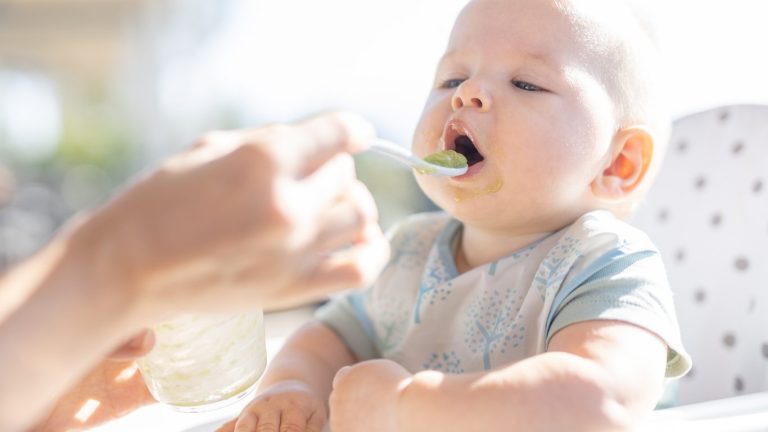In line with my holistic approach to babies, I am a firm believer in being led by the baby rather than a current way of thinking by any given institution. So, if a baby is showing all the signs of needing food at 4 months, I would start solids and if there weren’t any signs until 7 months I would wait. I am not sure where it comes from, but somehow it makes sense to me that having their needs met as and when required around food helps to set them up with a healthy relationship to it. At least I hope so.
Is your baby ready? These are the signs to watch for?
- Watching big people eat food – eyeing up the food on your plate and watching it all the way to your mouth. Sometimes salivating at the same time. Making faces that you might associate with chewing, smacking lips etc…
- Stuffing hands in mouth (can also be teething and the developmental phase of finding the hands)
- Needing more milk feeds day or night. A sense that they are not sated from milk alone, sometimes coinciding with good night sleeping habits changing to night waking and difficulty re-settling. Baby is a bit more grumpy and unsettled in general but is not unwell.
- Accepting a spoon in the mouth, rather than rejecting it with their tongue and when offered food they swallow it. (A mum mentioned to me recently that her baby stopped drooling when she noticed they were ready for solids – as in, started swallowing their saliva).
- I think a “reasonable amount of head control”, rather than a need to be able to sit unaided. I make sure that babies are in a seat that allows their backs to be fairly straight and not scrunched up – helps the food to go down easier, just like us with good posture.
What do you need?
A small easy to hold bowl or ramekin, small soft spoon, bibs, paper towel/tissues, soft moist wash cloth nearby, chair for baby to sit comfortably. (camera for the first time?)
How to prepare food
I batch cook fruits and vegetables in bulk and freeze in ice cube trays. Either a steamer or a small amount of water in a saucepan with a lid on top works well, using a gentle heat rather than boiling (this helps to retain nutrients). I find the easiest way to puree is one of those hand-held blenders, or a food processor. Spoon the puree into cube trays allowing for a little expansion as it freezes. I love the Mumi and Bubi freezer trays because they have lids. Cool, freeze, and turn out onto a clean surface or directly into the freezer bag. I use press seal plastic bags and squeeze out excess air from them to avoid freezer burn, and label them with contents and date.
I take the cubes out either the night before (thawing in the fridge) or on the morning it will be used and allow to defrost naturally, refrigerating once it has thawed if not being used immediately. Initially I warm it up in a small bowl in a larger bowl of hot water (this takes a little while, but I go about doing other things). When the quantities get bigger I use a small saucepan on the hob and add a little water with the lid on and warm thoroughly that way. (I have never felt the urge to sterilize any of the items used for weaning a baby. I really do not think it is necessary, but I do make sure that everything is clean to start)
Which foods to start with?
At the beginning of weaning it is recommended to introduce one new food every 3 days to watch for any reactions. The following foods are usually safe starting options.
Apple, pear, banana (raw, mashed), mango (can be raw – nice and ripe, or cooked), avocado (raw, mashed), butternut squash/pumpkin, carrots, sweet potato/kumara, swede, celeriac, broccoli, cauliflower, courgette.
Things worth noting:
Potato and other starchy foods don’t mix well from frozen unless heated up nice and hot, then cooled, carrot can be a bit like that too.
I would suggest that broccoli and cauliflower are given with another vegetable that is liked, as the texture sometimes puts them off.
Courgette is a very watery vegetable, I add a little less water to reheat when it’s in the mix.
Pear on it’s own can be really liquid also. This is where I might add a little baby rice/cereal to help to thicken it. It doesn’t need any milk added.
Bananas and baby rice have been known to cause constipation – if you have an issue with constipation with your baby, it’s good to be aware. You can offer more liquids with these foods. I usually offer a bottle or beaker of water with meals anyway.
In the same way that breast fed babies sometimes react to the foods that their mum has eaten, babies who are starting solids sometimes have wind issues with foods too. Bear this in mind if you notice any kind of discomfort after eating a specific fruit or vegetable, maybe you need to avoid for a short while and try again later on in the weaning process.
If you are like me and like stain free clothing then this bit is for you: The sugars in fruits stain! (and avocado) and it helps to take things off and wash/soak immediately. Carrot and tomato based dishes also stain, but I soak and wash and direct sunlight does the rest.
How much will they eat?
Again I am led by the baby. To start with it may be just a few very small spoons that they are willing to accept (1/2 an ice cube). I look for a willingness to make eye contact and engage with you, opening their mouth, even when the timing is out with the spoon, mouthing the food and then swallowing it. They turn their heads away and become disengaged from the process when they have had enough. They also start to spit it out repeatedly when they are done.
I really try to have the weaning process be a lovely experience. I respect the babies that I feed and check in with them throughout the process always gauging their response and reacting accordingly. I ask them if they are ready to start, if they would like more, and if they have had enough… I don’t talk to them or at them constantly while they are eating, trying always to bear in mind the question “would I like this situation if it was happening to me?”
If the baby eats the whole amount in the bowl, I would offer a little more. As long as it is a reasonable amount of food (and not way too much) I would allow the baby to dictate how much they would like to eat – just as I would with milk feeds.
When they start to eat more than 3 cubes in a sitting, I would do 3/4 vegetable cubes and then 2 fruit ones. Just like us they can get bored of the flavour, but still be a little hungry, and then devour another flavour easily.
Reactions to look out for
Start with one food every three days, watch for any reaction (this can be anything from a slight rash around the mouth to all over or patches of the body), nappy rash, stomach cramps, vomiting, diarrhoea, or worst case scenario anaphalatic reaction (this would commonly be from nuts/shellfish/eggs etc).
If there is a family history of allergies, it would be well worth consulting with your health care professional prior to starting the weaning process.
What if they choke?
I would highly recommend that anyone who has a baby/children or looks after them do a first aid course in case of emergency, but from experience I can share two things that I know first hand have worked.
If your baby starts to choke, STAY CALM!!! I really can not emphasize that enough – you panic, they panic!
The first thing that I learnt was in a baby swim class is that if they swallow water and it chokes them a little, simply lift one arm into the air. It alters the airway and can help things to move in the right direction. This has worked on numerous occasions.
The second thing that happened was with a four month old in my care was that is that he swallowed his pureed carrot the wrong way. He was turning purple and it was really quite scary. His mother was a neat freak and didn’t like mess, so I calmly took him out of his chair, walked over to the sink, lay him down my arm so that I was holding him face down with my hand spread across his chest and used the heel of my other hand to pat him twice firmly on the middle of his back. He was perfectly calm and happy when I lifted him up. He did have a few broken capillaries around his eyes though – so it was quite a close call, but it was the first aid training that did it, that, and staying calm.
Sweet vs Savoury
I typically would introduce apple or pear first (I really don’t think that baby rice is a nice thing to start off with, but that’s me). As soon as I have covered the 3 days of each apple and pear, I start on vegetables and then I shake it up as quickly as possible. I then would be offering the two course meal as described above.
The advantage of having all the cubes in separate sealed bags is that you can change the flavours/textures every day. Of course at some point it becomes easier to do a vegetable medley in larger quantities, but that’s probably also when you can start adding in meats and fish to change the flavours.
As a bridge to getting them from sweet onto savoury, you can mix fruit and vegetables together. Courgette and apple, and sweet potato and apple, banana and avocado all work well together.
When to feed?
Initially I would choose a time that is in between milk feeds that will not interfere with them too much and when both you and your baby are calm and happy. Also, I would want some time afterwards to watch for any kind of reaction, so I wouldn’t be doing it any later than 4/5pm in the day. Also, you want them to still be hungry for their last milk feed of the day before bed.
The reason I suggest that the first meal is around 4/5pm is because if night waking is an issue it is helping to stock them up, (this would shift closer to 5pm when lunch is introduced). The next meal I would introduce would be breakfast, after a milk feed (as morning and evening you are likely to be in the house anyway). I would suggest adding lunch last (simply because it has proven to be the most inconvenient – no other reason).
Initially the milk feeds are the most important thing. The solids are a top up to that. Then that balance shifts as their appetite grows and they would be having a schedule that looked roughly like this: 7am milk, 8/8.30am breakfast, a mid morning milk feed (equivalent to a snack), 12/12.30pm lunch, an afternoon milk feed (perhaps after nap time), dinner around 5pm and a milk feed before bed around 7/7.30pm.
The intention is to get baby onto three meals a day, but again I would be led by the baby as how long this takes. Typically I would see a progression over a period of 2-6 weeks of going from one meal a day to three meals. I personally don’t see any rush. Unless there is medical advice suggesting otherwise, you and your baby can take your time. Having said that. I would be looking to try to have baby eating the unsalted version of adult/sibling meals as much as possible between 12-15 months to make life easier all round.
Here is one of my exceptionally popular recipes for babies and their parents – it’s not exactly rocket science, but it is delicious!
Creamy apple recipe
6 apples
Flavour amounts dependent on individual tastes – I am usually generous with them.
1/2-1 t cinnamon
1/2-1 vanilla extract (preferable to essence)
Peel and slice apples. Place in a saucepan with a little water (once they start to cook they will produce moisture themselves). Add cinnamon and vanilla extract. Cook until soft. Puree thoroughly. It’s delicious! (as baby gets older, take some apple pieces out first, puree, then add the pieces back in cubed for them to chew). Freezes well.
Competition!
If you’re starting solids with your baby, you might like to enter our competition to win a mumi&bibi Solids Starter Kit!






Thank you so much Jayne for this i have been getting pushed to get my daughter onto solids for a while she is 7months and has just started, her older brother started solids at 4months it was great to see its just all about when they are ready. Also great to see the tips with food im a bit rusty on what to offer, was very informative and a easy read thanks again Danielle